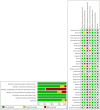A Mixed Comparison of Interventions for Kinesiophobia in Individuals With Musculoskeletal Pain: Systematic Review and Network Meta-Analysis
- PMID: 35846681
- PMCID: PMC9277051
- DOI: 10.3389/fpsyg.2022.886015
A Mixed Comparison of Interventions for Kinesiophobia in Individuals With Musculoskeletal Pain: Systematic Review and Network Meta-Analysis
Abstract
Objective: This systematic review aims to make a mixed comparison of interventions for kinesiophobia and individuals with musculoskeletal pain.
Methods: A comprehensive search strategy was conducted in the database of PubMed, MEDLINE, and Web of Science with the inclusion criteria: (1) randomized controlled design; (2) patients with musculoskeletal pain as participants; (3) treatments protocols of kinesiophobia as interventions or comparisons; (4) the score of Tampa Scale Kinesiophobia (TSK) as outcome measures. A network meta-analysis was used to synthesize the data after checking the model consistency. The risk of bias was assessed by the Cochrane Collaboration Risk of Bias Assessment Tool.
Results: Thirty-one studies were included in this review after a comprehensive search strategy with a low risk of bias and good consistency. According to the results of the network meta-analysis, a multi-modal treatment protocol had the highest probability to become the best choice in dealing with kinesiophobia caused by musculoskeletal pain, whereas psychological treatment protocols also showed a potentially positive effect on musculoskeletal pain-induced kinesiophobia.
Conclusion: Multi-modal protocols could be recommended as the preferred option when dealing with kinesiophobia caused by musculoskeletal pain. However, it is still worth mentioning that there are also potentially positive therapeutic effects of psychological interventions. Since the concept of kinesiophobia is based on the fear-avoidance model, the psychological mechanism should be paid enough attention to during treatment.
Registration number: CRD42021286450.
Keywords: kinesiophobia; musculoskeletal pain; network meta-analysis; non-surgical; systematic review.
Copyright © 2022 Huang, Xu, Xuan, Baker and Gu.
Conflict of interest statement
The authors declare that the research was conducted in the absence of any commercial or financial relationships that could be construed as a potential conflict of interest.
Figures




Similar articles
-
Effect of Multi-Modal Therapies for Kinesiophobia Caused by Musculoskeletal Disorders: A Systematic Review and Meta-Analysis.Int J Environ Res Public Health. 2020 Dec 16;17(24):9439. doi: 10.3390/ijerph17249439. Int J Environ Res Public Health. 2020. PMID: 33339263 Free PMC article.
-
Effects of manual therapy on fear avoidance, kinesiophobia and pain catastrophizing in individuals with chronic musculoskeletal pain: Systematic review and meta-analysis.Musculoskelet Sci Pract. 2021 Feb;51:102311. doi: 10.1016/j.msksp.2020.102311. Epub 2020 Nov 27. Musculoskelet Sci Pract. 2021. PMID: 33302214
-
Effects of exercise/physical activity on fear of movement in people with spine-related pain: protocol for a systematic review and meta-analysis.BMJ Open. 2022 May 19;12(5):e060264. doi: 10.1136/bmjopen-2021-060264. BMJ Open. 2022. PMID: 35589367 Free PMC article.
-
The Tampa Scale of Kinesiophobia: A Systematic Review of Its Psychometric Properties in People With Musculoskeletal Pain.Clin J Pain. 2023 May 1;39(5):236-247. doi: 10.1097/AJP.0000000000001104. Clin J Pain. 2023. PMID: 36917768
-
The effects of kinesiophobia on outcome following total knee replacement: a systematic review.Arch Orthop Trauma Surg. 2020 Dec;140(12):2057-2070. doi: 10.1007/s00402-020-03582-5. Epub 2020 Aug 24. Arch Orthop Trauma Surg. 2020. PMID: 32839826
Cited by
-
Unraveling the impact of kinesiophobia on proprioception and balance: Mediation by pain, mobility, and psychological wellbeing in post-total hip replacement recovery.PLoS One. 2024 Dec 5;19(12):e0314627. doi: 10.1371/journal.pone.0314627. eCollection 2024. PLoS One. 2024. PMID: 39636869 Free PMC article.
-
Neural-Targeted Rehabilitation Strategies to Address Neuroplasticity After Joint Injury.J Athl Train. 2024 Dec 1;59(12):1187-1196. doi: 10.4085/1062-6050-0215.23. J Athl Train. 2024. PMID: 39099551 Review.
-
Longitudinal Validation of a Specific Measure of Fear Avoidance in Athletes: Predicting Time from Injury to Return to Sports Competition.J Pain Res. 2023 Mar 30;16:1103-1114. doi: 10.2147/JPR.S396054. eCollection 2023. J Pain Res. 2023. PMID: 37020665 Free PMC article.
-
Specific versus general exercise programme in adults with subacromial impingement syndrome: a randomised controlled trial.BMJ Open Sport Exerc Med. 2023 Sep 27;9(3):e001646. doi: 10.1136/bmjsem-2023-001646. eCollection 2023. BMJ Open Sport Exerc Med. 2023. PMID: 37780129 Free PMC article.
-
Association of Kinesiophobia with Catastrophism and Sensitization-Associated Symptoms in COVID-19 Survivors with Post-COVID Pain.Diagnostics (Basel). 2023 Feb 23;13(5):847. doi: 10.3390/diagnostics13050847. Diagnostics (Basel). 2023. PMID: 36899992 Free PMC article.
References
-
- Andersen T. E., Ellegaard H., Schiottz-Christensen B., Mejldal A., Manniche C. (2020). Somatic experiencing for patients with low back pain and comorbid posttraumatic stress symptoms - a randomised controlled trial. Eur. J. Psychotraumatol. 11, 1797306. 10.1080/20008198.2020.1797306 - DOI - PMC - PubMed
-
- Archer K. R., Devin C. J., Vanston S. W., Koyama T., Phillips S. E., Mathis S. L., et al. . (2017). Cognitive-behavioral-based physical therapy for patients with chronic pain undergoing lumbar spine surgery: a randomized controlled trial. J. Pain 18, 477. 10.1016/j.jpain.2017.02.425 - DOI - PMC - PubMed
-
- Armijo-Olivo S., Stiles C. R., Hagen N. A., Biondo P. D., Cummings G. G. (2012). Assessment of study quality for systematic reviews: a comparison of the Cochrane Collaboration Risk of Bias Tool and the Effective Public Health Practice Project Quality Assessment Tool: methodological research. J. Eval. Clin. Pract. 18, 12–18. 10.1111/j.1365-2753.2010.01516.x - DOI - PubMed
-
- Beltran-Alacreu H., López-de-Uralde-Villanueva I., Fernández-Carnero J., La Touche R. (2015). Manual therapy, therapeutic patient education, and therapeutic exercise, an effective multimodal treatment of nonspecific chronic neck pain: a randomized controlled trial. Am. J. Phys. Med. Rehabil. 94(10 Suppl. 1), 887–897. 10.1097/phm.0000000000000293 - DOI - PubMed
Publication types
LinkOut - more resources
Full Text Sources

